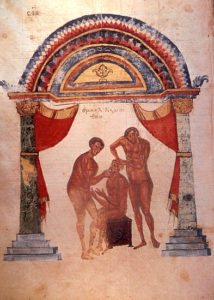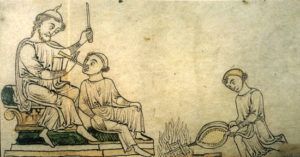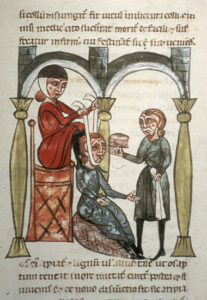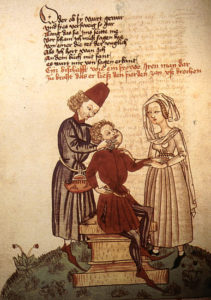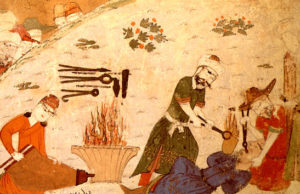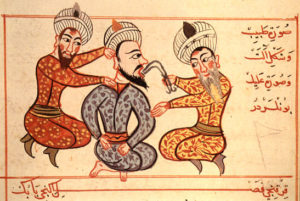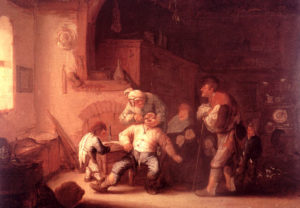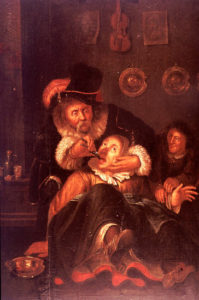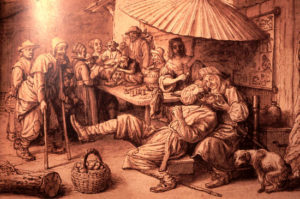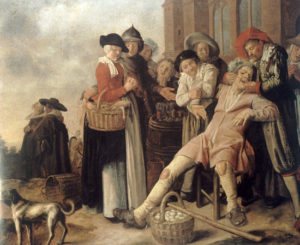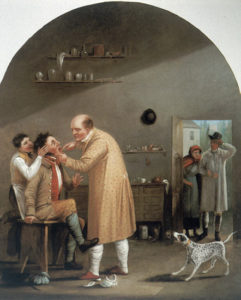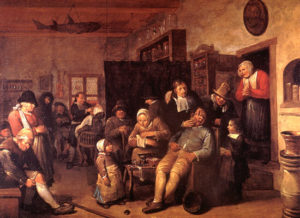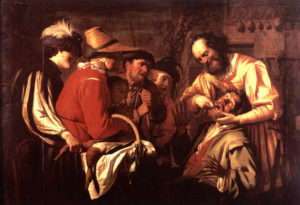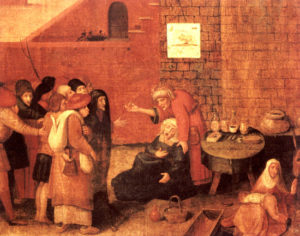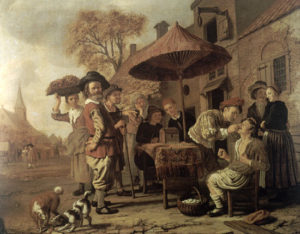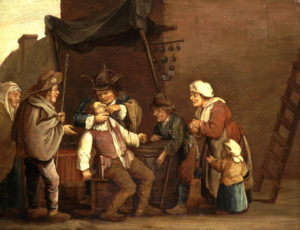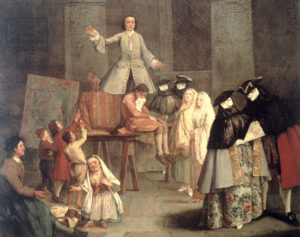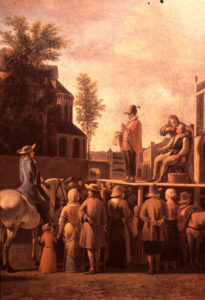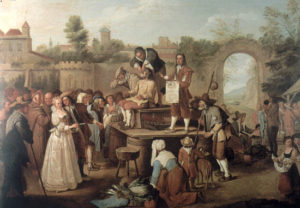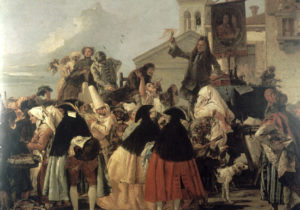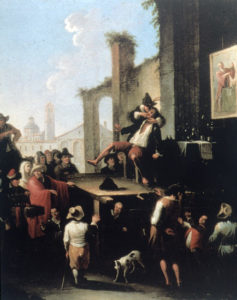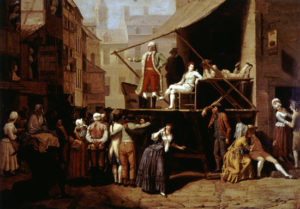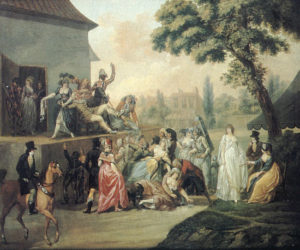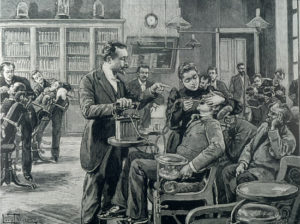par Pierre BARON
For the periods former to photography and the cinema, we have to see only graphic arts which enable us to visualize the dental scenes. The detailed study of paintings, drawings and engravings representing of the dental scenes does not cease giving us invaluable information, only could one say, on what could be the working conditions of the dentist, i.e. on its immediate environment. It is necessary, however, to make a small reserve with regard to the realism of these scenes by taking account of artistic interpretation, if there is one of them, and of the will of the painter to transmit certain messages by symbols often difficult to decipher. This last point concerns mainly the Flemish and Dutch painters of XVIIe century, who painted a very great number of scenes of kind, and, among them, of the scientific, medical and dental scenes.
The first witness : the assistant
The witness nearest known couple expert-patient is, without any doubt, the assistant. It is that or that which is in the forefront of the witnesses, privileged witness of what is done and of what is said.
The first representation of an assistant is particularly old, since it dates from IXe-Xe century (800-900 ad) . It is a color drawing which forms part of the Codex Nicetas (ms Laur Plut 74.7 C f° 198 v°) preserved at Biblioteca Medicea Laurentiana in Florence.
An assistant helps the expert to reduce a lower jaw luxation by holding the head of the patient
Rough two hundred years later, i.e. towards 1100-1200 (XIIe century), a color drawing of Ruggero da Fruggardo illustrating its Chirurgia (ms O 1. 20) preserved at Master and Fellows of Trinity Library College in Cambridge, shows us the assistant, which is a young monk, poking fire with bellows to make heat the cauteries.
The treatment of certain dental pathologies by cauterization was very in vogue at that time. One sees the expert on the left sitting, belonging to the cauteries
It is in a manuscript of Rolando da Parma dating from the end of XIIIe century, itself inspired by Ruggiero da Palermo (1180), entitled Cyrurgia and preserved at Biblioteca Casatanense in Rome (ms 1382) which we find a color drawing showing us (f° 19 r°) another reduction of lower jaw luxation.
Here the assistant holds the linens being useful to make the binding of application. It seems to sympathize with the suffering of the patient The expert and the patient are women.
In XVe century, we selected several representations of the assistant:
First of all we will see a drawing illustrating a German manuscript of 1467. This manuscript is preserved at Landesbibliothek of Stuttgart (Cod. Poet. 2°2) and shows us an expert extracting a tooth with a patient.
The expert, of Eastern appearance with his arab hat, is positioned perfectly. He is helped by an assistant who holds the patient by the hand and the shoulder
Of XVe century also, a drawing illustrating a famous book which title is Châh -Namé (the Book of the Kings) of Abu’ L Qasim Firdusi (930-1020). This Persan manuscript (ms suppl. Persan 443) is preserved at the BNF (National Library of France).
The drawing (f° 363 v°) shows us an expert, sitted behind the patient lying (position described by the Arab doctors and which was perpetrated until the beginning of Xxe century), extracting a tooth and helped by two assistants. One, on the left pokes fire with bellows, and the other, on the right, holds with a grip fire near the expert.
Same time, Charaf-ed-Din(1404-1468) left us its famous Chirurgie of Ilkhani, written and illustrated by him into 1465-1466. This manuscript (ms suppl. Turkish 693 LI) is preserved at the BNF (National Library of France).
Very many drawings being able to illustrate our matter. We see here one of them: a dental extraction (chapter 20 f° 80 v°). The expert is in front of the patient and the assistant behind and holds the head to him.
We now will approach the XVIIe century and its very many representations of dental scenes.
Adriaen van Ostade (1610-1685), Dutch painter, left us this indoor scene dated towards 1630-1635 and preserved at Kunsthistorisches Museum of Vienna.
The expert, placed behind the patient, is spirit to extract a tooth to him, while the small assistant holds a dish while attending the scene. There are some witnesses in the second plan, perhaps the family of the patient and another being pressed on a long stick and looking at attentively the work of the expert
Gerrit van Honthorst (1590-1659), Dutch painter having left many scenes of kind, is a follower of Caravage like many Dutch painters called the » Caravagesques of North « . This extraction dental and signed and gone back to 1622. The painting is preserved at Staatlische Kunstammlungen of Dresden.
The assistant holds a candle to light the field of work. The expert is held behind the patient while the witnesses, very interested are held in front of
Joos van Craesbeck (1608- circa 1654/1662) is a Flemish painter. He shows us here, preserved in a private collection, the interior of a barber-surgeon.
The expert is held behind the patient sitting on the ground. He makes an extraction while an assistance holds the hand of the patient while fixing her glance on the mouth of this one.
Now let us examine this superb pen-and-ink drawing and washing of Lambert Doomer (1623-1700) preserved at Ashmolean Museum in Oxford.
his Dutch drawing is remarkable, not only by its exceptional artistic qualities, but still by the perfect ergonomic position of the expert compared to the patient and the assistant who holds a flask, all sheltered under a parasol. Many witnesses attend the scene, while others are interested by the delousing practised by a monkey, another assistance of the expert, on a man.
This table painted by Jan Miense Molenaer, Dutch, (1610-1668) representing a dentist, is preserved at Anton Ulrich Museum of Brunswick, shows us a true charlatan who seems to simulate a dental care. Its assistant, to confirm the intention of the author who is to show dishonesty of the quacks, has a malicious look, mocking of that which is rather an accomplice that an assistant.
Among the witnesses who are seeing the scene there is a lady which joined, for it sympathizes with the pain of the patient who is between the hands of the quack. This lady is being made strip by a robber, perhaps another accomplice: he steals its poultries to him which are in its basket.
Of XIXe century we can examine this painting of S. Cox, British painter, preserved at the library of Wellcome Institute in London.
The assistant holds the head of the patient while the dentist works. Two witnesses are held with the entry of the cabinet, with a few meters from there.
Of XXe century we will retain this painting made by Edouard Tytgat (1879-1957): it is signed and gone back to 1930. It forms part of a private collection.
The assistant, carries an apron and a white cap, like the blouse of the dentist, is held beside the patient and supports it. It is in this representation a spectator very close to work of the expert.
It is with this table of Tytgat that we can close the chapter of the assistant or privileged assistant-witness nearest to the work of the dentist. We now will see other dental scenes where it does not act any more an assistant or of the assistant but of the other witnesses.
The latter can be numerous, especially when the travelling dentist assembled trestles on a place of market or in a fair, and that on these trestles of the jokers or small actors employed by the dentist, some small theatrical improvisations or some parades play to attract the customers. When the scene occurs inside the witnesses are in a more restricted number.
Indoor scenes
Let us take some examples of dental paintings of indoor scenes, and to begin this table of Egbert van Heemkerck (1634-1704), Flemish painter. This painting is preserved at the Museum of Beaux Arts of Ghent.
he scene occurs in the common room from work from a barber and a surgeon. In addition to the two experts fifteen people are. A man is shaving the beard in the content of the shop, while another, in the first plan, is in care with the surgeon . The expert is wiping the cheek of the patient where there is a few blood. It is probable that the extraction of a tooth has just been done. Some witnesses are attentive, others probably await their turn while looking at the expert working.
The painting of Theodore Rombouts (1597-1637) is very famous. This Flemish painter left us, him or his pupils, of very many versions of this scene. There is also a great number of old copies. This version is one of two the best: it is preserved at the Museum of Beaux Arts of Ghent, the other being with the Museum of Prado in Madrid.
Six witnesses attend the scene, whose two adopt an attitude which shows that they are very interested by the extraction which the quack is doing: on the left on the first plan a man pressed on his cane holds his eyeglasses on the nose for better seeing, and the other, young person, is pressed on the table where the instruments and flasks are spread out, looking with a great interest too. The two men who are on the right of the charlatan are speaking about their teeth as it is visible.
Gerrit van Honthorst (1590-1659), Flemish painter of which we saw a painting a few moments ago, left us another dental scene. This painting is preserved at the Museum of the Louvre in Paris.
There are four witnesses, one of them is a robber. In this connection it should be recalled that the presence of this robber, relatively frequent in this kind of scene could have a value symbolic system, like the presence of the monkey. Both are the malignant ones and robbers: it is a manner of informing crowd to be wary of the quack who is malignant and robber. Here there is another symbol of this type: the false diploma with its seals. Be careful you don’t be fascinate by appearances
Outside scenes
Already a century ago, Pieter Bruegel the Older (1525/1530-1569), Flemish painter, had shown us a robber acting. It is about a scene of outside entitled Christ driving out the merchants of the Temple, and gone back to 1556. She is preserved at Statensmuseum for Kunst in Copenhagen.
There is in this broad scene on the left the dentist with some witnesses of which a robber acting, the hand in the basket of a woman.
Let us pass now with other scenes of outside, and let us start with one of those of Jan Victors (1620-1674) which is Dutch. This painting signed and gone back to 1654 is preserved at Rijksmuseum in Amsterdam.
This painting of Jan Steen (1625-1679), Dutchman also, date of 1651 and is preserved at Mauritshuis in the Hague : as we already saw a woman has the hands joined in sign prayer.
Still a spectator with the hands joined in the table of the Dutchman Andries Both (1612/1613-1641). This painting exists in several versions: this one is in a particular collection.
Peter Jansz Quast (1606-1647) another Dutchman shows us here a dentist installed on trestles. This painting is preserved in the Communal Museums of Verviers.
Some witnesses attend this scene into which the painter slipped three symbols: the false diploma, the monkey and the owl. Let us recall that the owl is the symbol of deceived – here the patient-. Dutch the proverb used known as: » That the candle and the glasses are not essential if the owl cannot or does not want to see « .
In XVIIIe century this kind of scenes will rarefy. Pietro Longhi (1702-1785), Italian painter left us a dental scene preserved at the Brera Museum in Milan.
It is a scene of carnival in which the witnesses are masked and disguised.
Theatrical outside scenes
To finish we will now see paintings with travelling dentists who assembled trestles on which move of jokers or small actors who say some scenes or parades to attract crowd
Oldest is at the end of XVIIe century. It goes back to 1680 approximately and is painted by Gerrit Berckheide (1638-1698) painter Dutch. It is preserved at Staatmuseum of Cologne.
It shows us a true scene of theatre with some actors on trestles assembled in full shift. A crowd of witnesses attend with the spectacle and the dental care.
At the beginning of XVIIIe century Balthazar van den Bossche (1681-1715) left us this scene gone back to 1710, preserved at the Royal Museums of Beaux Arts from Belgium in Brussels and entitled » the puller of teeth on the Grand Place in Brussels « .
Here also it is a true small theatre which is assembled in the center of the Grand Place. Crowd is numerous to attend the event: the dentist out of middle-class clothes is held on the front of the scene with in the hand a flask or a tooth. On his line, another man is bowing in front of the crowd assembled near of the trestles, holding with the hand an object. On its left a masked harlequin, is pulling the curtain to let appear the preparer of drugs or elixirs.
From the beginning of the XVIIIe century also this scene painted by the Fleming Peter Angillis (1685-1734) and preserved in a private collection : there are boards which are posed on four barrels and the scene itself can be circumvented by the passers by.
A dentist is operating a patient sitting on pedestal: the dentist, him even on the pedestal, is upright behind him. On its left a man equipped well harangue crowd showing the false diploma, with at its sides a box of flasks intended to be sold. On the right side of the dentist an actor who is miming the pain of the patient. The scene is particularly animated with children, sellers of poultries, a pilgrim in departure for Saint Jacques de Compostelle, monks and a couple of middle-class man.
Another testimony of these travelling dentists: the scene painted by the Italian Faustino Bocchi (1659-1742). It forms part of a private collection.
Here a characteristic: all the characters are dwarves. Two other Italian painters of XVIIIe century left us dental scenes being able to illustrate our matter. The first painting is of Giandomenico Tiepolo (1727-1804). It is signed and gone back to
1754 and is with the Museum of the Louvre in Paris.
This scene of carnival is also equipped with trestles on which are moving actresses and actors in costume. Many disguised witnesses attend the spectacle. Second is of Michele Granieri (active in Turin about 1770 and died in 1778). This table is preserved at Museo Civico of Turin.
Here there are no actors but the way in which the trestles are assembled evokes a theatre completely. Witnesses attend the scene.
We will now see a very beautiful painting carried out by the Flemish painter Léonard Defrance (1735-1805). This painting is in a private collection.
That occurs downtown, the trestles are leaned at a house. The dentist, richly equipped, probably shows with the public a tooth that it has just extracted, with the young woman sitting at side. The latter with the very calm air and discusses with a young man lengthened on the belly on a table with trestles. In the content is held a disguised character.
Another scene of the end of XVIIIe century interesting to see is French, and painted by François Watteau says Watteau of Lille (1758-1823), private collection.
It is Arlequin who operates and Pierrot which is the unhappy patient who seems to suffer: it adopts the typical attitude that painters, in a vast majority, solidified, i.e. an arm in the air (sign of defense) and a foot which is not any more on the ground (sign of pain). A smart ladies, very well dressed, with a beautiful low neckline and a large hat holds the right arm to him, and a Sir, almost bald person, are interested of very close in Pierrot (which it makes exactly?). On the front of the scene, another character seems to pour a liquid on first witnesses(?). A the background another harlequin, with his hood, talkative with a young woman, while an older woman is held in the narrow opening of the curtain. The trestles are covered with woven and the scene itself constitutes the way in of a house whose door opens on the scene.
Lastly, a watercolour of J.A. Langendijk DZN Dutch painter (1780-1818) private collection, shows us still better this atmosphere of fair where the dentist has his place on a scene of theatre.
We are at the beginning of the XIX ième century. Crowd is very numerous and each one is occupied making its races or even with speaking with others. But most of this public is turned towards the dentist who operates a patient. A disguised actor has the hand of the patient who suffers and other a trumpet in which it blows, at the same time to cover the possible cries of that which suffers and to attract crowd. On left of this group another actor disguised also with the air to blow of smoke. A monkey is held on a piedestal perched high on the front of the scene. The curtains are opened and held by decorated boards, on the pediment of which one can read the name of the dentist
Conclusion
Only of a century ago we can see on this engraving of the end of XIXe century of Leon Tynaire (1861-?), coming from the National Museum of the Education of the Holy Mount Aignan, a room of the Dental School of Paris where the teacher is the single witness, for it gives councils to the girl pupil.
At the beginning of XXe century there were still travelling dentists who operated in the streets: some photographs, well-known, Parisian dentists of the streets, are last testimonies of these scenes now disappeared from the modern countries. But many are those among us, having attended these dental scenes in the open air with the Third World countries, can still testify to their direct bond with the tables which we have just seen. Actually, in the modern countries, there is no more care in the streets and the patients prefer discretion, except in dental universities and schools.

